Japan's first Super Express
Part 2
TSUBAME Ride Experienced during July of 1930
Before Tsubame started on the 1st of October 1930, two test runs were conducted.
The first test was made on the 4th of December 1929, and the 2nd was on the 3rd of July 1930.
This story was written by a Trip magazine reporter in regard to that ride experience on the 2nd test run on the 3rd of July 1930.
And this article was published during August 1930 from that travel magazine "Tabi".
The article was written in the 1930's Japanese colloquial style.
The original Japanese sentences were hard to understand and the Japanese was similar to English written in Shakespeare's times.
I am not a professional translator or an English teacher .......
However, I intended that I would translate the original Japanese as close as possible.
But, some sentences were impossible to completely translate into English.
Therefore, I took liberty in translation, I hope you can forgive me for it.
|
***********************************************
|
Gaining a sense of the new era
with the running of the Superexpress,
riding to the exultation for all the passengers.
Masao Sato, author
| | | |
|
On the 3rd of July (1930) 7:23 a.m. ,the day of the superexpress trial run made the 600 Kms
between Tokyo and Kobe in 8 hours 55 minutes as the forerunner of the Speed-Era.
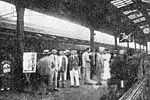
The Trial Tsubame started
3 minutes before
Tokyo station
|
The station was jammed with test-riding passengers and their friends to see them off.
News reporters buzzed among the crowd with cameras at the ready.
They were in a rush to report on the 1930's model in their newspaper account.
I watched the station clock advance, little by little,
as the long hand crept from the 12 to the one and finally to the four,
indicating that it was twenty minutes past the hour of seven,
and at that point the excitement was registered on the faces of everyone
there and then the moment of the trains arrival at seven twenty three !!!!
Two minute ! One minute ! On Time !!
" Hey you ! Heads up !! Take care you don't fall from the deck ! "
" Thank you ! "
Very slowly the Class-51 began its pull with all its tractive power,
soon increasing its speed, so that its arrival at Shimbashi was as quick as a wink and just as fast,
it was on its way......
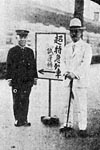
|
Left,Tokyo station manager Mr.Yoshida, and on the right Railway Minister
Mr.Egi on the Tokyo station platform.
The direction board mentioned "Superexprees train. Test run."
|
"What was its actual time ? "
....ONE MINUTE !!!!
The following stations flew by like the wind of a storm....... Hamamatsucho, Tamachi and beyond.
Such exhilarating speed !!!
Before one can say Shinagawa or Omori,
we are already alongside the clean platform of Yokohama and its first stop.
"What time is it ? ".... seven-forty-nine .... someone whispered.
" Oh ! exactly on time, its right on with the timetable ...
great ! "
" 66.2 Km between Tokyo to Yokohama .... it ran it in 26 minutes ! "
" OK, then, what about the Limited express and it's running speed ? "
" The Ltd. Express probably ran about 53.8 Km/hr and needs 32 minutes,
so, the superexpress reduced the time by 6 minutes, and if compared with a local train,
its shortened by 9 minutes.
By the way, I want to say, this is a 100% SUPER-Express."
After leaving Yokohama and running with the morning breeze,
the Superexpress ran up to 71 km/hr before its second stop at Kozu !
For the many eyes of those crowding along the tracks,
the C51 represented the eras new front line of engine development.
Somehow, for no particular reason, a sense of superiority came over me as I rode.
"Someone said, the engineer is Mr. Taguchi who has experience with the royal-train for many years !? "
" Yes ! I have often taken the Ltd. express, this train was a bit smoother than that of the Ltd. expresss,
bearing testimony of his driving skill."
" Even though the passenger cars were not made for this superexpress
they gave one the sense of a smoother ride and as I listened to the wheels beneath I felt a drowsiness coming on. "
The scenery from the car flashed by in a maze of color and motion and even the power poles and cedar trees seemed as blended into one !
" Hey ! the train seems a bit slower now !? "
" Do you know the reason for that ? "
" No, I don't, but maybe we are climbing a mountainous section ......... "
" Yes, now you're talking !!. Perhaps, we are running at 55 Km/hr right now.
The Ltd. Expresses can only make about 40 Km/hr around this section. Well one thing is sure,
if you were not looking from the window, the difference between the slower speed and the higher would not be very apparent. Hahaha ..... "
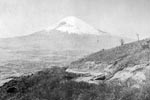
Hakone pass and Mt.Fuji
During 1931
|
With the assisted coupled engine, the C53 can make the 2.5 % uphill slope with comparative ease in regard to atmospheric pressure differential,
much as if a comparison were to be made with a person and the probable difference between a regular and an experienced mountain climber.
Passengers exclaimed ! ....
" This is the only way to go over (*1) Hakone Pass ....on a train like THIS. !!!
(*1 Hakone pass .... the hardest mountain part on the Tokaido since early times.)
Shimotsuga, Matsuda, Yamakita, Suruga .....
all these sections passed on by in a comfortable rhythm of the mountain atmosphere finally arriving at (*2) Gotemba yard.
(*2 Gotenba ..... a summit city on Hakone pass.)
We say our final Good-Bye to the pusher engine.... thank you for your assistance !!!!....
and our superexpress gradually backs away to continue its journey onward.
" What a dramatic scene ".....someone exclaimed !
" Yes, I see what you mean" ....the sight of the well wishers and those taking leave !
In this area only the crown of beautiful Mt. Fuji was seen, the rest of which was obscured.....
its a bit sad, I thought, ... for had I seen it all, it would have been a capital day indeed !
After passing through Mishima and Numazu stations with 9:38'30" official time,
the time represented from the Tokyo departure was 2 hours and 15 minutes,
which was an hour and a half less than local trains and one hour and ten minutes less than limited expresses........
"Its like a swift-running heavenly warrior" on the thoughts of many.
Crews were changed at Numazu while the train was running, but passengers did not know it .....
they only said " It rides well indeed !! "
I still recall the exhilarating ride on the flat portion of the trip
from Numazu and passing on through Hara and onward to Suzukawa.
"Well we made 90 Km/hr !!" exclaimed Mr. S smiling broadly.
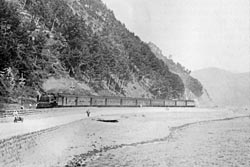
Tsubame runs at the foot of
the Fuji mountain area at Hara, Suzukawa
with the C53 during 1934.
|
Chinese often say the equivalent of "Shigeki o suguru" as a metaphor for "very fast".
"Shigeki" means a " Four horse carriage".
Superexpress speed is anything but a four horse carriage !
If four horse carriages were still the fastest in the world,
perhaps, the old mustached general (*3) Nagaoka might challenge the Superexpress in a race on the Tokaido,
also he might sell his beloved horse for a faster horse.
But, even a horse lover like the General, would know that times are changed.
And he would probably say that " Shigeki o sugurumo nao Cho-Tokkyu ni oyobazaranya " ....
( I cannot beat a superexpress, even if I used a four horse carriage.).
(*3 Gaishi Nagaoka 1858-1933, A Japanese army's general. He had a 70cm mustache.)
Well, where was I ?
Oh yeah, I remember, I wanted to let you know about how fast the run was from Numazu to Suzukawa......
therefore I'm racking my brain !?
But the Chinese, of course, even thousands of years ago made very intelligent sayings and proverbs.
When I wrote the superexpress article, I was surely digressing ;
Even four- horse carriages have no chance against my idle chatterings ....
After all, I'm no match for Chinese ancestors and their long historical insights.
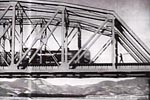
Fuji river and C53
During 1937
|
Oh !! the train has already passed Shizuoka, while I chattered about trivial matters.
Let me now refer to the historical chokepoint..... the Ooi River.
In past years, this was the most difficult place for the traveler .... as luck would have it,
flooding often occurred and blocked travel.
This, of course created a multitude of problems and consequent added time and expense.
But on this day.....the crossing is less than one minute...... 45 seconds flat !!!!!
This brings to mind an old Japanese tale in regard to the Ooi-river in olden times and a Japanese heroine named Asagao.
She chased after her lover to the Ooi-river, but was not able to pass because of flooding.
Of course Asagao couldn't go across and turned back with tears in her eyes, ...
such was the Ooi river 200 years before.
After the Tsubame begins regular service please give it a try for an enjoyable experience.
Let me by way of comparison relay the following :
I smoke a brand of cigarette named Shikishima with a red mark on its paper
and the Ooi river was crossed on the Tsubame before the cigarette burned to that mark in this year of 1930.
I had hoped to have smoked the entire cigarette while crossing but Tsubame dashed that hope !
We have passed Kanaya and Kakegawa was in a blink of an eye.
And so soon, already the Tenryu river.
Hamamatsu station swept by at 11:27, and I'm getting hungry.
Spectators viewing the passing train may well imagine
that the trains passengers are enjoying peaceful dining in the dining car feasting on salads and beer.....
but god forbid, it is said that newspaper people must eat paper itself and that is literally the case....
not even coffee ....nothing !

Nagoya station and C53-3
During 1934
|
We arrived at Nagoya station at 12:55 p.m. We had a stop of 5 minutes.
Now is a chance to catch a beer or soft drink and perhaps an ice cream which
are sold through the windows by hawkers at the station.
Also on board we have two teen age starlets who have created a great
deal of interest of fans who are all in hope of catching a glance...... among those who do, we hear,
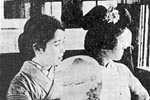
Eiko Azuma and Fusako Fujita on the trial superexpress.
|
" Where is (*4) Eiko Azuma !? "
" Also Fusako Fujita is here !! "
" ... they have grown up a lot ! "
" They seem very sexy .... "
but its train time and even the beautiful flowers must be on their way.
"We want to see more.... more.... and more", but alas, in the end all that remains is the enthusiasm of the fans.
(*4 Eiko Azuma and Fusako Fujita were 1920s-1930s movie actresses.
They participated in the test-driving of the superexpress.)
Again we started ! 1 p.m. !
We leave behind the many who thronged the station and Nagoya in the distance.
My stomach is still complaining, because I didn't drink even a drop of water since breakfast until now.
I was given a (*5) 30-sen box lunch at Nagoya station.
I started to eat the box lunch which was scarcely opened before, but now that I'm eating it .......
how delicious, what a good salty taste !
" Being so hungry, the 30-sen box lunch hit the spot !? "
" It seems to be a special-lunch only for today.
But I'm not sure, no matter how hungry, my stomach guess is absolutely right.
This is a special entertainment lunch for superexpress passengers only for today."
" But is that for sure ....... ?? " ..... I do not know .......anyway it's great !!
(*5 30-sen .... Sen was a old Japanese currency unit. 100-sen = 1 yen.)
I opened a bottle of beer .... and poured it into a paper cup.
I know I'm repeating myself, but the ride is very smooth !!
The 80% poured beer in the paper cup, was put on the window sill as a trial.
The beer was slightly spilled from the vibration but was soon replaced with a frothy head !!!
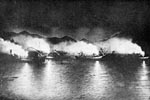
U-Kai on the Nagara river
During 1931
|
Having crossed the Kiso river, we are coming up to the city of Gifu's urban area.
Eiko Azuma and Fusako Fujita are talking with a folded fan in one hand and looking out of the window.
During this time camera men are taking photos.
Perhaps the starlets are wishing to " see the (*6) U-Kai on the Nagara river ... "
as they whisper to each other as they see the beautiful scenery pass by.
It appears that Eiko's speech is more old fashioned for her age and perhaps one should not listen too closely out of respect.
This I will do........
(*6 U-Kai .... Cormorant fishing. A kind of the bird-fishing.
It can be seen even now in Gifu.)
We passed Gifu at 1:26 p.m., and arrived at Ogaki at 1:38.
There was a 1% uphill section between Ogaki and Maibara, therefore, the speed was down to about 64Km/hr,
but it was still fast.
I took the regular express when I returned, and I once again ran the same section, however,
that express speed and this superexpress had almost the same speed as the express and local train.
The Maibara to Otsu section speed was 74.5 Km/hr and only second to that of Toyohashi and Nagoya.
We arrived at Kyoto at 3:07 p.m., and after 36 minutes arrived at Osaka.
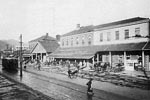
Kobe station
During 1930s
|
I got off the train at Osaka and went to a Japanese inn : I relaxed in the bath,
and I deeply dragged on a smoke which also was very relaxing, and I slowly blew it out.
Around the same time at 4:22 p.m., the superexpress glided over to the platform at Kobe and received a tumultuous welcome,
without a delay of one minute.
Thus, ended the exciting spectacle made by the Super-Express's down-train trial operation
and the curtain was brought down in successful conclusion.
|

Part 1

|
|
Top menu
|
| |

